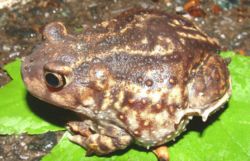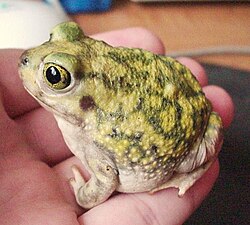American paddock toads
| American paddock toads | ||||||||||||
|---|---|---|---|---|---|---|---|---|---|---|---|---|

Western blade root ( Spea hammondii ) |
||||||||||||
| Systematics | ||||||||||||
|
||||||||||||
| Scientific name | ||||||||||||
| Scaphiopodidae | ||||||||||||
| Cope , 1865 |
The American shovel- foot toads (Scaphiopodidae), also called shovel- feet for short , are a family of the frogs (Anura). They represent the North American "counterpart" to the European paddle- toed toads (Pelobatidae), which include the common spadefoot toad . However, they are even more closely related to the mud divers , with whom they form the superfamily Pelodytoidea. Their sister group are the toad frogs (Pelobatoidea). The delimitation of the Scaphiopodidae family is based on DNA examinations; previously all paddock toads were included in the family Pelobatidae.
features

As with all toad frogs and paddock toads, the first thing you notice is the vertically slit pupil of the eyes. The clumsy shape with a short, sharply sloping snout is very similar to the European garlic toad or the knife foot . Just like these, the American shovel feet have the eponymous “digging shovels” on the underside of the hind feet - hardened, sharp-edged horn structures with which the animals can dig themselves backwards into the ground very quickly. The skin of the adult amphibians, which grow to be about six to nine centimeters in size, is relatively smooth and moist and contains numerous glands that secrete a secretion that sometimes smells strongly of mold. This serves primarily to protect against dehydration and parasites, but also to ward off predators. The mating call of the males of some species is described as a loud, sheep-like "moaning bleating". The "concerts" of the Eastern Shovel Foot are said to be particularly inharmonious for the human ear.
Habitat, way of life
The Scaphiopodidae family has a number of notable characteristics compared to other amphibians. It populates predominantly arid grass steppe and semi-desert areas , and the animals spend a large part of the year buried meters deep in the sandy soil in order not to dry out. You can cope with a loss of almost 50% of your body weight through water evaporation . Another adaptation to the very inhospitable habitats for amphibians is the sophisticated reproductive biology. On a rainy summer night, the shovel feet of the area gather at small, mostly only temporarily existing water points such as puddles or wild swamps to spawn there. The larvae hatch on the second day after egg-laying and, in extreme cases, only need 12 to 15 days to metamorphose into land animals (for comparison: the tadpoles of most Central European frogs need around two and a half to three months; the ecologically most comparable one Natterjack toad can sometimes do it in three to six weeks).

However, it can also take six weeks for the shovel feet to go ashore - the tadpoles may react at the rate of their development to the probable duration of the water accumulation. It is also conceivable, however, that there is simply a lack of sufficient food (algae, organic suspended particles, carrion) in newly created puddles. Then even sludge is absorbed, which certainly delays the individual development. At best, however, they show an astonishing growth rate: the larvae sometimes double their body size within a day.
When eating, the tadpoles show a certain social behavior in that they swim in swarms close to the ground and benefit from the fact that the "man in front" stirs up the organic sludge of the soil by flapping its tail. In other situations, however, the animals behave again opportunistically : If a conspecific is injured or dies, he is eaten up by the others - an economically sensible behavior in the sense of species conservation in the event of a food shortage in order to utilize all available resources . If overpopulation occurs in waters that have become too small or lacking in food, it can lead to pronounced cannibalism in the larval population. It has even been established that in such situations some tadpoles develop different mouthparts for a short time and suddenly mutate into carnivores compared to their algae-consuming conspecifics. This is also ultimately due to the species' advantage that at least some individuals accelerate the metamorphosis before the pond dries up, while otherwise all would have perished. If they manage to transform, a mass phenomenon can also be observed here in that all animals develop their previously missing front legs at the same time and then go ashore together like an invasion. The toads reach sexual maturity after one to two years. Until then, they feed on insects and other invertebrates , which they hunt at night - preferably in rainy weather.
distribution
Most of the blade root species occur in the southwest and west of the United States , some still on the northern edge of Mexico . They can then occasionally occur syntopically to several species - in the same biotope . Spea bombifrons penetrates east along the Rocky Mountains , i.e. in the Great Plains , further north. Spea intermontana also reaches somewhat higher northern latitudes in the western United States and also colonizes more mountainous landscapes. Scaphiopus holbrookii is the only blade root in the eastern United States.
species
The American paddock toad family consists of two genera with 7 species:
- Genus Scaphiopus Holbrook, 1836
- Species Scaphiopus couchii Baird, 1854 - southern blade root
- Species Scaphiopus holbrookii (Harlan, 1835) - Eastern blade root
- Species Scaphiopus hurterii Strecker, 1910 - Hurters blade foot
- Genus Spea Cope, 1866
- Art Spea bombifrons (Cope, 1863) - lowland blade root
- Species Spea hammondii (Baird, 1859) - Western blade root
- Art Spea intermontana (Cope, 1883) - New Mexico blade root
- Species Spea multiplicata (Cope, 1863) - mountain blade foot
Individual evidence
- ↑ García-París, M., DR Buchholtz & G. Parra-Olea: Phylogenetic relationships of Pelobatoidea re-examined using mtDNA. - Molecular Phylogenetics and Evolution 28 (2003): 12-23.
- ↑ Darrel R. Frost: Scaphiopodidae Cope, 1865. In: Amphibian Species of the World: an Online Reference. Version 6.0. American Museum of Natural History, New York 2016, accessed June 12, 2016.
literature
- Günther E. Freytag, Bernhard Grzimek, Oskar Kuhn & Erich Thenius (eds.): Lurche . In: Grzimeks Tierleben, Vol. 5: Fish 2, Lurche. Licensed edition in dtv, Munich 1980, ISBN 3-423-03204-9
Web links
- Darrel R. Frost: Scaphiopodidae Cope, 1865 . In: Amphibian Species of the World: an Online Reference. Version 6.0. American Museum of Natural History, New York 2016, accessed June 12, 2016
- List of species of the Scaphiopodidae family at Amphibiaweb
- Photos of Scaphiopus couchii